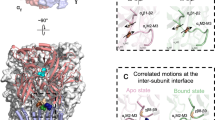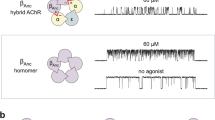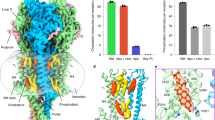Abstract
Hypotheses concerning the mechanism by which acetylcholine-like agonists cause ion channels to open often suppose that the receptor–ionophore complex can exist in either of two discrete conformations, open and shut1–3. On the basis of noise analysis it has been reported that certain agonists open ion channels of lower conductance than usual4–8, though many potent agonists give similar conductances9–13, and hence that differences in the conductance of ion channels opened by different agonists may contribute to differences in efficacy14. Here we have reinvestigated this question by recording single ion channel currents15 evoked by acetylcholine-like agonists on embryonic rat muscle in tissue culture and on adult frog muscle endplate. Ten different agonists (Fig. 1) were tested, including several that noise analysis has suggested have a low conductance4,5. The single-channel conductance was found to be the same, within a few per cent, for all 10 agonists. It seems that noise analysis has given erroneously low conductances in some cases. Therefore efficacy differences do not depend on differences in single-channel conductances evoked by various agonists but presumably on the position of the open–shut equilibrium of the agonist–channel complexes16.
This is a preview of subscription content, access via your institution
Access options
Subscribe to this journal
Receive 51 print issues and online access
$199.00 per year
only $3.90 per issue
Buy this article
- Purchase on Springer Link
- Instant access to full article PDF
Prices may be subject to local taxes which are calculated during checkout
Similar content being viewed by others
References
Katz, B. & Miledi, R. J. Physiol., Lond. 224, 665–669 (1972).
Anderson, C. R. & Stevens, C. F. J. Physiol., Lond. 235, 655–691 (1973).
Changeux, J. P. Harvey Lect. 75, 85–254 (1980).
Colquhoun, D., Dionne, V. E., Steinbach, J. H. & Stevens, C. F. Nature 253, 204–206 (1975).
Dreyer, F., Walther, C. & Peper, K. Pflügers Arch. ges. Physiol. 366, 1–9 (1976).
Spivak, C. E., Waters, J., Witkop, B. & Albuquerque, E. X. Molec. Pharmac. 23, 337–343 (1983).
Auerbach, A., del Castillo, J., Specht, P. C. & Titmus, M. J. Physiol., Lond. 343, 551–568 (1983).
Stettmeier, H. & Finger, W. Pflügers Arch. ges. Physiol. 397, 237–242 (1983).
Gray, P. T. A. & Rang, H. P. Br. J. Pharmac. 80, 235–240 (1983).
Jackson, M. B., Lecar, H., Askanas, V. & Engel, W. K. J. Neurosci. 2, 1465–1473 (1982).
Peper, K., Bradley, J. & Dreyer, F. Physiol. Rev 62, 1279–1340 (1982).
Anderson, C. R., Cull-Candy, S. G. & Miledi, R. J. Physiol., Lond. 282, 219–242 (1978).
Cull-Candy, S. G., Miledi, R. & Parker, I. J. Physiol., Lond. 321, 195–210 (1981).
Stephenson, R. P. Br. J. Pharmac. 11, 379–393 (1956).
Hamill, O. P., Marty, A., Neher, E., Sakmann, B. & Sigworth, F. J. Pflügers Arch. ges. Physiol. 391, 85–100 (1981).
Castillo, J. Del & Katz, B. Proc. R. Soc. B 146, 369–381 (1957).
Hamill, O. P. & Sakmann, B. Nature 294, 462–464 (1981).
Auerbach, A. & Sachs, F. Biophys. J. 42, 1–10 (1983).
Ogden, D. C. & Colquhoun, D. Pflügers Arch. ges. Physiol. 399, 246–248 (1983).
Colquhoun, D. & Sakmann, B. in Single Channel Recording (eds Sakmann, B. & Neher, E.) (Plenum, New York, in the press).
Sakmann, B. Fedn Proc. 37, 2654–2659 (1978).
Colquhoun, D., Large, W. A. & Rang, H. P. J. Physiol., Lond. 266, 361–395 (1975).
Sakmann, B., Bormann, J. & Hamill, O. Cold Spring Harb. Symp. Quant. Biol. 48, (in the press).
Ruff, R. L. J. Physiol., Lond. 264, 89–124 (1977).
Ruff, R. L. Biophys. J. 37, 625–631 (1982).
Neher, E. J. Physiol., Lond. 339, 663–678 (1983).
Colquhoun, D. in Cell Membrane Receptors for Drugs and Hormones (eds Straub, R. W. & Bolis, L. (Raven, New York, 1978).
Barlow, R. B., Thompson, G. M. & Scott, N. C. Br. J. Pharmac. 37, 555–584 (1969).
Author information
Authors and Affiliations
Rights and permissions
About this article
Cite this article
Gardner, P., Ogden, D. & Colquhoun, D. Conductances of single ion channels opened by nicotinic agonists are indistinguishable. Nature 309, 160–162 (1984). https://doi.org/10.1038/309160a0
Received:
Accepted:
Issue Date:
DOI: https://doi.org/10.1038/309160a0
This article is cited by
-
On the nature of partial agonism in the nicotinic receptor superfamily
Nature (2008)
-
Agonist‐activated ion channels
British Journal of Pharmacology (2006)
-
Binding, gating, affinity and efficacy: The interpretation of structure‐activity relationships for agonists and of the effects of mutating receptors
British Journal of Pharmacology (1998)
-
Activation of subconductance states by ?-aminobutyric acid and its analogs in chick cerebral neurons
Pfl�gers Archiv European Journal of Physiology (1990)
-
Multiple-conductance channels activated by excitatory amino acids in cerebellar neurons
Nature (1987)
Comments
By submitting a comment you agree to abide by our Terms and Community Guidelines. If you find something abusive or that does not comply with our terms or guidelines please flag it as inappropriate.



